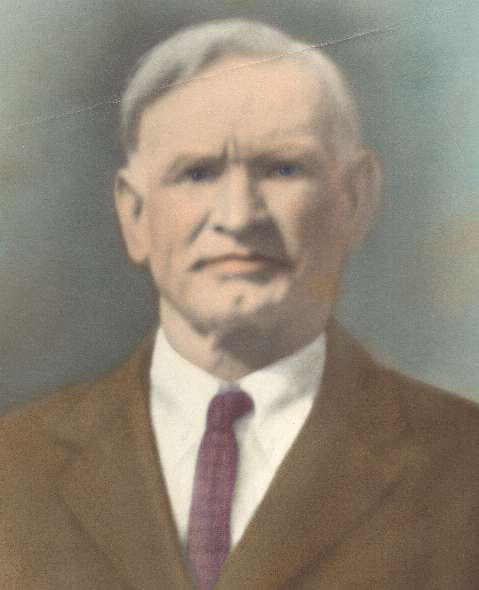
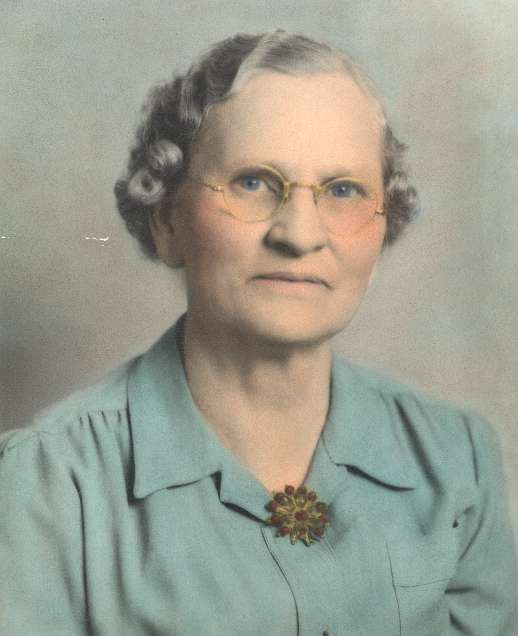


Life History of John McDonald Rider
and His Wife Rhoda Laura Jensen Rider
Narrated by Rhoda Laura Jensen Rider
Written by Elda Rider Yancey in 1941
Rhoda Laura Jensen was born 29 September 1876 at Spring Lake, Utah County, Utah, the sixth child and second daughter in a family of eight children, three of whom died as infants. Her parents were Lars Rover Jensen and Elizabeth Ann Freestone.
When I (Rhoda Laura Jensen Rider) was two years old, my parents moved to Orderville, Kane County, Utah, and joined the United Order. The houses were small and built side by side forming four walls, like a fort, with a large hall in the center. We had community prayer in the mornings before breakfast and prayer after supper as well as our meetings in the hall. There was a long table in the hall at which all of our meals were eaten. We were not allowed to have food in our homes. If we wanted a piece we had to snitch something from the orchard or garden. Bro. Robinson blew a bugle to call us to breakfast and supper. At noon a bell rang. All the food was cooked in a big kitchen. There was an orchard and fields of vegetables and cotton.
There was a large herd of cows and cheese and butter were made. There was also a factory where we made our own cloth and blankets. Everyone worked at what they could. My father herded sheep. Mother did a lot of spinning and knitting and made all of our clothes. My oldest brother, Reuben, worked in the carpenter shop. Annie worked in the factory and kitchen and Frank worked in the carpenter shop when he was old enough.
After a few years they discontinued eating at the big table and gave each family its supplies according to its size. I remember getting a small bucket of milk each morning for our family of seven. We were allowed our flour and so many fruits and vegetables each week. When father took his third wife he moved to Provo Branch where he lived until his death from old age. Mother and we children stayed in Orderville.
I was baptized in Orderville Creek. I went to school in a one-room schoolhouse and had only one book and a slate. I belonged to the Primary, M. 1. A. and the Sunday School. I was very fond of horses and a good hand at handling them. , We used to always ride sideways with only a strap to hold to.
When I was about fourteen there were two ladies and two little girls visiting in Orderville who asked me to drive them to their home in Castle Valley. As we started up Salina Canyon we were warned by a farmer that there were lots of bear and it wasn't safe for women to travel alone. We had an old team and a covered wagon and were on the road, which was not much better than trails, more than a week. We weren't afraid. We unhitched the horses that night and I took them to water and then tied them tight because they seemed nervous. I went out to gather some fire-wood since there was none close to our camp. I had gathered a good armful when I heard a noise behind me and turned to see a huge black bear. I looked at it and it looked at me. I dropped the wood and ran screaming to the wagon. We watched the bear scamper up the mountain. We were too frightened to go after more wood so we sat huddled in the wagon all night. The little girls had some cold lunch. We had a terrible night - the horses stomped and snorted and we heard all kind of screeches and noises. The next evening we camped early where there was plenty of firewood.
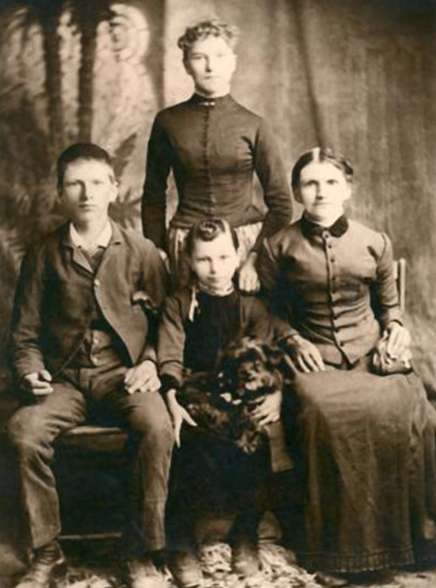
Rhoda Laura Jensen standing in the back.
in front: James Franklin, Emma Jane and mother: Elizabeth Ann Freestone Jensen.
When I was seventeen I became engaged to a young man of whom my mother disapproved because he smoked. She was broken hearted about it and prayed that I would be guided right. It was at this time that I was taking the part of Topsy in the play, Uncle Torn's Cabin, which we were putting on in Kanab. I was working for Mrs. Riggs. I finished my work and went out on to the porch and sat down in a big rocking chair where I must have fallen asleep in the warm sunshine. In a dream I saw a young man driving a herd of cattle up the road. One of the cows jumped over the fence, and the young man let the bars down and let her out, It seemed that a voice said, "That is your future husband. 11 When I awoke I felt very strange. I sat there and in a short time a young man came by driving a herd just as I had dreamed. He let the bars down for the cow that had jumped over. I watched him drive down the road into Riders. I broke my engagement with the other young man. I have always felt that this dream was an answer to my mother's prayer.
After John and I were married we made our home in Kanab. Our first child, Reba Elizabeth, was born May 21, 1895, at the home of my friend, Annie Pughs. Bennie and Annie Porter who were living in Basalt, Idaho, wrote and told us what a good country it was, so my brother Reuben Jensen went to Idaho to look around. He was able to buy land for four dollars an acre. We were able to buy eighty acres.
We started for Idaho in October with a team and covered wagon. Our bed was in the back of the wagon with the sewing machine under it. We had a few cooking utensils and dishes, a sack of flour, a bacon, a ham, dried apples and prunes, and our clothes. We used a lantern for a light. By putting a home made rug over the wagon bows under the canvas we made our wagon quite warm. It was raining when we arrived in Basalt the latter part of November 1896. Potatoes were frozen in the ground. Idaho looked like a sagebrush desert. The houses were few and far between. We moved into an old log house but when the weather turned to forty below zero we were unable to keep warm and moved in with Annie and Binnie. They had a little two-room house and five children. John and Binnie hauled wood from across the river on the ice. We had no money and would have starved to death if John Shelley had not let us have credit at his store. John found a job doing carpenter work when the weather warmed up.
In February there was a chinook wind which melted the snow and ice. Our horses fell through the soft ice and were drowned. We had only a wagon and set of harness left to start in a new country. A good friend, Samuel Haycock, traded a team of horses and an old harness for our good new harness. John cleared some ground4and planted grain and then he hauled timber from the mountains and built us a one-room log house. It was here that Lenna Mary was born September 7, 1897. The next year John hauled timber and built a two-room log house and we used the old one for a granary.
John had to clear our land by hand so each year he would clear another field and after he had put the crops in he would leave in April to shear sheep and would be gone three months. He made all the money we had and enough to pay for our farm doing this.
Fern was born May 8, 1900. We had our farm pretty well under way by this time. We had horses, cows, sheep, pigs and chickens. We could not hire help but had to exchange work with our neighbors.
In October 1900 John was called on a mission. He took me and the children to live with his parents in Salt Lake City. When he went to the temple to be ordained they noticed that he was quite badly crippled with rheumatism. They told him they didn't want sick men in the mission field and gave him an honorable release and promised him he could go later when he was well.
We moved back to Basalt. John Ellis, our first son, was born October 27, 1902. The next morning after Reba had gone to school and John had gone to take Marie home, Lenna came running in and told me the house was on fire. I couldn't believe that it was but when she opened the kitchen door the smoke came rolling in. I got out of bed, which was unheard of at that time with a baby less than a day old, and made my way to the kitchen and put out the fire, which was on the wall behind the stove, by throwing water from the buckets on the wash stand and by dipping water from the reservoir of the stove. Then I carried the buckets and filled them at the ditch and emptied and the fire seemed to be out. I went back to bed thinking that I would surely die. Lenna knelt by my bed and prayed for me. When John returned and found what had happened, he summoned a neighbor and they administered to me promising me that I would get well. I was in bed about three months.
In the spring of 1905 we bought a house in Basalt. It was good to be close enough for the children to walk to school. We could walk to church. Always before we had to hitch up a team to the whitetop. It was about this time that Religion Class was organized. Bro. Talbot was the first Supt. and I was his assistant.
On the 14th of January, John and Mr. Berg were called to a special Priesthood meeting in Blackfoot. It was at this meeting that John was called on a mission to serve as Bishop of the Woodville Ward. It gave me the opportunity to go on a miss ion with him as I had said I would like to. Although I was reluctant to leave Basalt, we moved to Woodville the following spring. We bought a seventy acre farm on the edge of the townsite with a young orchard and a nice four-room house. We had the first drilled well, as well as the first telephone. We made a lot of new friends. I served as secretary of the Relief Society. I was President of the Y. L. M. 1. A. until Elda was born June 29, 1907. Later I was President of Primary.
John was Bishop for about five years. After he was released we sold our place and moved to Draper but had to move back to Woodville to reclaim our place.
In August 19 15 1 became ill with gallstone and it was necessary for me to have an operation. They moved a pint of gallstones and a kidney. They did not think I could live more than six months but after a long time I recovered and was able to get around all right.
On August 13, 1916 Clifford was accidentally shot in the stomach while playing with a 22 rifle. He died the next day and was buried in the Woodville Cemetery on the 15th. After that we sold our farm in Woodville and after looking around bought a forty acre farm in Rose, five miles north of Blackfoot.
John was called on a short term mission, leaving November 20, 1925. His headquarters were at Atlanta, Georgia.
Our children were all married by 1941. We sold our farm to the boys about that time and built us a little house on the corner of the farm.
Throughout the years we have loved to travel. First by team and buggy or wagon and later by car, sometimes with our children or grandchildren and sometimes alone. We visited Yellowstone Park several times. We have been to southern Utah and the Carlsbad Caverns and went to Mesa, Arizona with Elda when she and Orley were married. We made a number of trips to Parma and Whitebird, Idaho, and to Vale, Oregon to visit our children. We went to Mud Lake several times a year and enjoyed going to the Craters of the Moon and out to Lost River as well.
Rhoda Laura died November 1, 1944, at her home in Rose of a heart attack. John M. passed away a little over a year later on Christmas Day, December 25, 1945, at a Blackfoot Hospital following a lingering illness. They are buried side by side in the beautiful Fielding Memorial Park Cemetery near Idaho Falls, Idaho, The funeral of each was conducted from the Rose Ward Chapel with Bishop Marvin R. Harper officiating. At the time of John M. Is death, only his wife Rhoda and his son Clifford preceded him. Eight children survived as did eight grandchildren and twelve great grandchildren, each grateful for the heritage given them by these two stalwarts--each appreciative of the trials, hardships and sacrifices endured by them, and the many teachings and philosophies of life left by them--truly grateful for the memory of them.
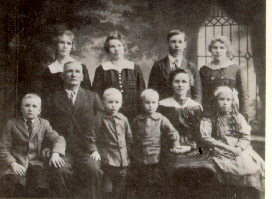
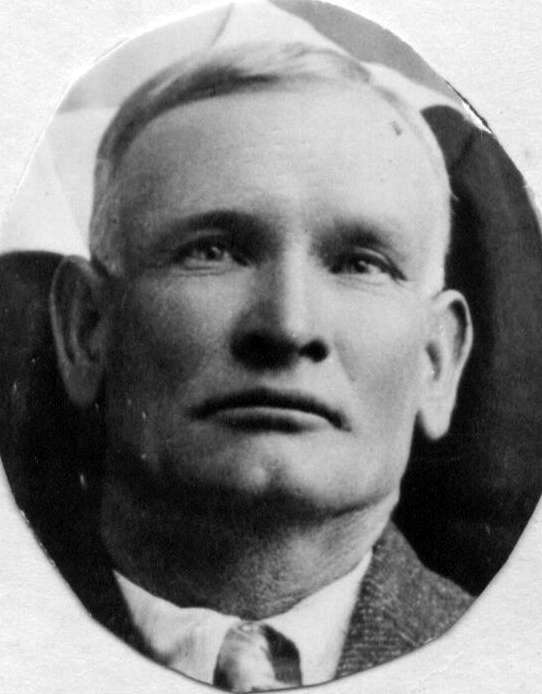
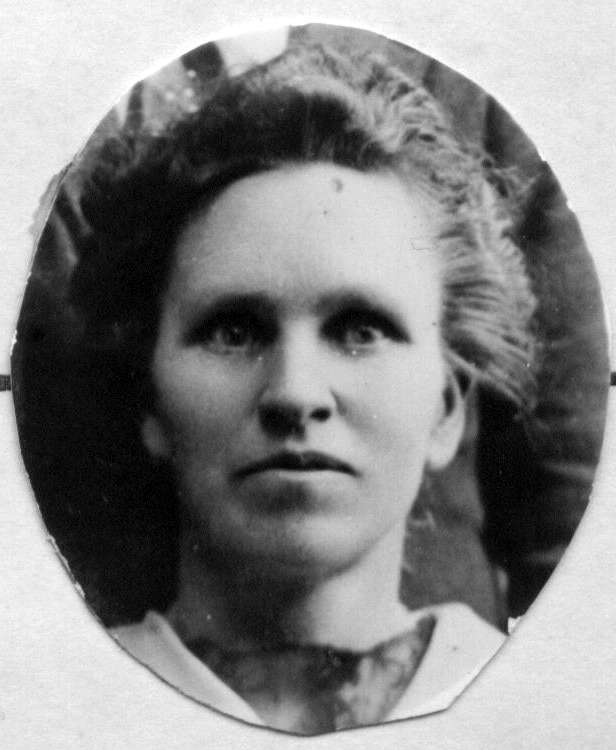
Life Sketch of John McDonald
Rider
and Rhoda Laura Jensen
Compiled by Leona Salisbury
John McDonald Rider was born 23 April 1868 at Cottonwood, Utah, the son of John Rider and Mary McDonald. He was the oldest in a family of thirteen children, eight boys and five girls. When John was only two years old his father was called by President Brigham Young to help settle Southern Utah and with his family moved to Kanab, Utah.
In a humble home environment, well acquainted with privations and hard work, John M. Rider grew up. While he was yet a mere lad, he herded cows in the valley during the day, making up songs and poems as he watched. He loved his old brown horse, the cows he herded, and especially the wide open spaces and the red colored hills of the valley's edge. As he sat on his pony watching the cows, he would dream of someday owning a large herd.
As John grew older he was relieved of his task of herding cows by his younger brothers while he, having grown tall and broad shouldered, would work in the grain fields and his father's grist mill. He was baptized in the Kanab reservoir in 1877.
Eager to earn his own living, John, at the age of sixteen years, gained permission from his parents to work for Jim Stewart herding sheep for twenty dollars a month and his food. Jim's range was on the north rim of the Grand Canyon in Arizona. Here the tall, rugged Kaibab Mountains rose straight up from the deep Grand Canyon gorge.
John enjoyed herding sheep in this enchanting place, high on the Buckskin Mountains in the summers and down in the valleys in the winters with only the sheep, the dogs, and a stray coyote or cougar to keep him company. He was alone most of the time. Someone would take him supplies every few weeks. Occasionally he would go into town where he was eager to learn of the happenings among his circle of friends.
After working for Mr. Stewart for four years, John had been able to save enough money to start in the cattle business. He stopped herding sheep, bought one hundred and fifty head of cattle, and secured some rich rangeland near the Grand Canyon on the Arizona side. John's childhood dreams then came true.
John rode the range each day. In the evening the men would gather around a small grass4and brush fire, while John, strumming his guitar, would sing in his clear tenor voice--(he was a good hand at playing the organ, harmonica, and accordion, as well). John especially enjoyed the round up in the fall, when both the cattle and wild horses would be driven from the range into large corrals. A rodeo always ensued and John, an excellent rider, would enjoy himself immensely riding the wild horses.
John, with five other boys, rounded up three hundred head of wild horses, loaded them on the train and took them to the Chicago World's Fair for President Heber J. Grant. After an enjoyable trip and a very interesting time, John returned home to be greeted by his friend Will Thompson, in whose care he had left his cattle, and the bad news that his cattle were dying. They were choking to death.
Three weeks before when John had left for Chicago, the tips of the blades of grass had already begun to wither and the supply of water in the watering holes had begun to disappear. All the cattlemen had expected rain but it had not come this year. Now the grass stood parched and yellow on the flat tableland. The water in the waterhole had completely disappeared, leaving only white alkaline rims. A haze hovered over the sunbaked earth. The cattle, dotting the pasture land, stood motionless, their heads hanging limply from their too prominent shoulders, their tongue hanging from their partially opened mouths. The sun glistened on their bony backs and the flies, having no interference, buzzed busily. The cattle too weak to stand lay on the ground as they had fallen, some dead and the rest dying. It was a sickening sight-but nothing could be done. Feeling a bitter disappointment and sick at heart, John turned his horse and rode wearily toward Kanab.
For the next two years John worked incessantly. At the end of this time he had been able to buy fifty head of cattle and a few horses. In the meantime, he met Rhoda Jensen. She, with a group of amateur actors from Orderville, Utah, presented a play, Uncle Torr's Cabin, in Kanab. John was twenty-six years old at that time and played the organ in the orchestra for the dance after the show.
Rhoda, a small, lively, light complexioned girl, had smeared charcoal on her face and played the part of Topsy in the play. While in Kanab, 4she was offered a job doing housework for Rachael Riggs, which she readily accepted. A new girl in a small town was not overlooked. Consequently lively Rhoda met John Rider. On a horseback riding date, John let Rhoda ride his best horse ''Babel'. When he asked her how she liked his horse, she replied, 11wonderful". She said she would like to have a horse like that for her own. John told her that the girl who became his wife could have her. Rhoda replied, ''All right, she belongs to me. " And so they were engaged. As a result early on the morning of the following April the twentieth, John and Rhoda, accompanied by a chaperone, set out for St. George in a whitetop buggy pulled by two sleek horses. They had planned on being married on the 23rd, John's birthday, but since they did not perform marriages on Mondays they were married the following day April 24, 1894 in the beautiful L. D. S. Temple. After a three-day honeymoon, the newlyweds returned to Kanab where they were greeted by a blaring brass band and the town's entire populace which escorted them to a new log cabin at the edge of the village. John's- mother served cake and home made beer. John brought two gallons of Dixie wine from St. George to serve to the fellows.
